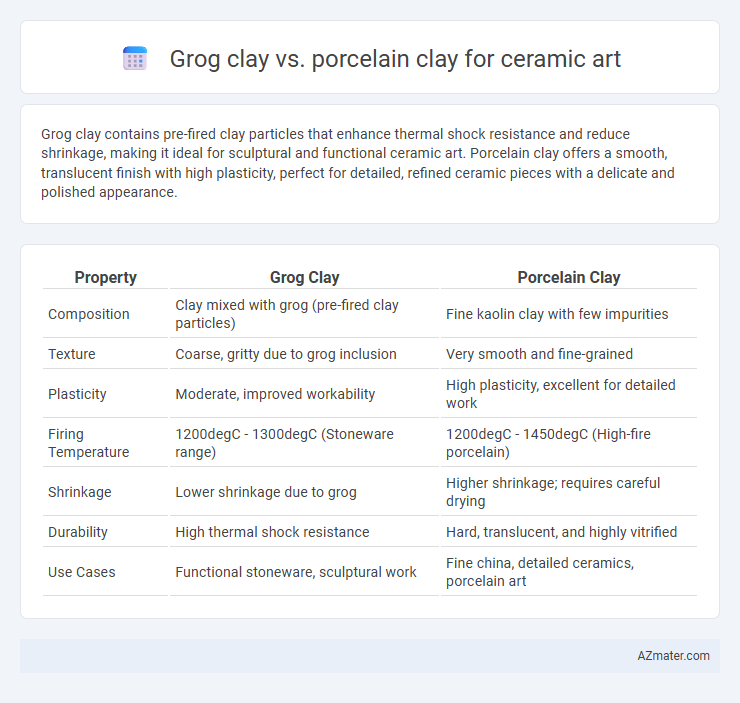Grog clay contains pre-fired clay particles that enhance thermal shock resistance and reduce shrinkage, making it ideal for sculptural and functional ceramic art. Porcelain clay offers a smooth, translucent finish with high plasticity, perfect for detailed, refined ceramic pieces with a delicate and polished appearance.
Table of Comparison
| Property | Grog Clay | Porcelain Clay |
|---|---|---|
| Composition | Clay mixed with grog (pre-fired clay particles) | Fine kaolin clay with few impurities |
| Texture | Coarse, gritty due to grog inclusion | Very smooth and fine-grained |
| Plasticity | Moderate, improved workability | High plasticity, excellent for detailed work |
| Firing Temperature | 1200degC - 1300degC (Stoneware range) | 1200degC - 1450degC (High-fire porcelain) |
| Shrinkage | Lower shrinkage due to grog | Higher shrinkage; requires careful drying |
| Durability | High thermal shock resistance | Hard, translucent, and highly vitrified |
| Use Cases | Functional stoneware, sculptural work | Fine china, detailed ceramics, porcelain art |
Introduction to Grog Clay and Porcelain Clay
Grog clay contains pre-fired clay particles that improve strength, reduce shrinkage, and enhance texture, making it ideal for sculptural and hand-building ceramic art. Porcelain clay is composed of fine kaolin with a smooth, white, and translucent finish, prized for its delicate appearance and high firing temperature tolerance. While grog clay offers durability and a tactile surface, porcelain clay provides refinement and precision in ceramic artwork.
Composition and Material Differences
Grog clay contains pre-fired, crushed ceramic particles mixed into the clay body, enhancing its thermal shock resistance and reducing shrinkage during firing, making it ideal for sculptural and functional ceramic art requiring durability. Porcelain clay, composed primarily of refined kaolin, feldspar, and quartz, offers a smooth, highly plastic texture with a white, translucent finish after firing, favored for delicate and fine ceramic pieces. The inclusion of grog in clay increases strength and texture, while porcelain's fine particle composition allows for precision and a glossy, glass-like surface.
Workability and Sculpting Characteristics
Grog clay contains fired clay particles that improve workability by reducing shrinkage and minimizing cracking, making it ideal for hand-building and sculpting detailed textures. Porcelain clay offers a smooth, fine-grained texture with high plasticity, allowing for precise, delicate sculpting but requiring careful handling due to its tendency to warp and crack during drying. Sculptors often choose grog clay for robust, textured pieces, while porcelain is favored for refined, intricate forms with a polished finish.
Firing Temperatures and Process
Grog clay contains pre-fired clay particles that improve thermal shock resistance and reduce shrinkage, making it suitable for lower firing temperatures around 1,000degC to 1,200degC, ideal for stoneware and sculptural ceramics. Porcelain clay, with its fine, high-purity kaolin content, requires higher firing temperatures typically between 1,200degC and 1,450degC to achieve vitrification and translucency, resulting in a denser, strength-oriented final product. The firing process for grog clay allows for better drying and reduced warping, while porcelain demands slower, more controlled firing cycles to prevent cracking and ensure optimal hardness.
Surface Texture and Finish
Grog clay contains pre-fired clay particles that create a rougher surface texture, enhancing grip and reducing shrinkage during firing, making it ideal for rustic or textured ceramic art. Porcelain clay offers a smooth, refined surface with a glass-like finish after firing, allowing for delicate detail and a high level of translucency in ceramic pieces. Artists select grog clay for tactile, earthy aesthetics, while porcelain clay is preferred for sleek, polished works with a pristine, elegant finish.
Strength and Durability
Grog clay contains pre-fired clay particles that enhance strength and reduce shrinkage, making it highly durable for heavy-duty ceramic art pieces. Porcelain clay, while finer and more delicate, offers remarkable strength after firing due to its high vitrification point, resulting in a dense and glass-like finish. The choice depends on whether the project requires rugged durability with resistance to cracking (grog clay) or a smooth, refined appearance combined with strong structural integrity (porcelain).
Suitability for Handbuilding vs. Wheel Throwing
Grog clay, with its coarse texture and added grog particles, offers excellent structural support and reduced shrinkage, making it highly suitable for handbuilding techniques such as slab construction and sculpting. Porcelain clay, known for its smooth, fine texture and high plasticity, is ideal for wheel throwing, enabling delicate, precise forms with a refined finish. While grog clay provides durability and stability for large handbuilt pieces, porcelain excels in creating thin-walled, symmetrical vessels on the wheel.
Glazing Compatibility and Effects
Grog clay contains pre-fired clay particles that reduce shrinkage and improve thermal shock resistance, making it ideal for functional ceramics with stable glazing surfaces. Porcelain clay, known for its fine, smooth texture and high vitrification, tends to produce more translucent and refined glazed finishes but requires careful temperature control to prevent defects like crazing or blistering. The grog in clay bodies enhances glaze adherence and durability, while porcelain clays offer a delicate glaze effect favored in fine art ceramics.
Common Uses in Ceramic Art
Grog clay is commonly used in ceramic art for creating robust, textured, and functional pieces such as pottery, tiles, and sculptures that require durability and resistance to thermal shock. Porcelain clay is preferred for fine, delicate, and highly detailed ceramic art, including dinnerware, decorative objects, and intricate figurines due to its smooth texture, translucency, and high firing temperature. Both clays serve distinct artistic purposes: grog clay enhances structural integrity and surface texture, while porcelain clay offers a refined, elegant finish ideal for precision work.
Choosing the Right Clay for Your Project
Grog clay contains pre-fired clay particles that add texture and reduce shrinkage, making it ideal for large, functional ceramic pieces requiring durability and reduced cracking. Porcelain clay offers a smooth, glass-like finish with high plasticity, perfect for delicate, detailed work and fine art ceramics demanding translucency and elegance. Selecting between grog and porcelain clay depends on project requirements such as strength, texture, firing temperature, and desired surface finish.

Infographic: Grog clay vs Porcelain clay for Ceramic art
 azmater.com
azmater.com